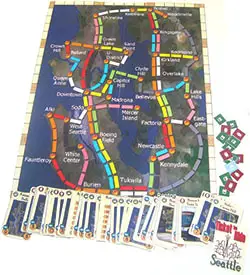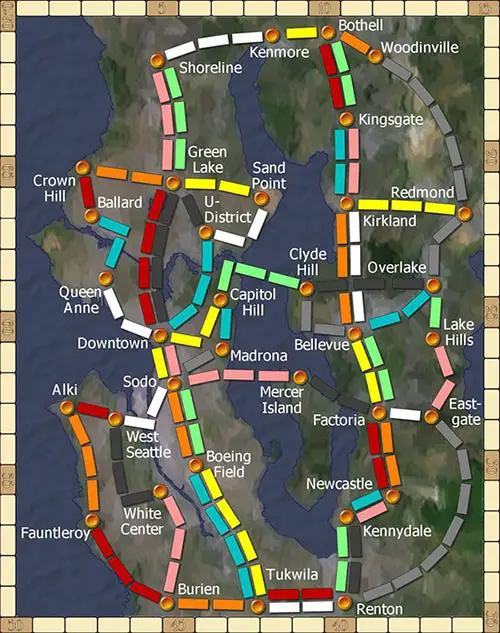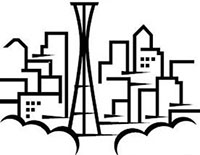
Fan expansion by Jesse McGatha & Richard Thames Rowan
Components
You will need or can find included in this package:

- the Ticket to Ride: Seattle game board
- A standard set of train cards (called automobile cards in this game) from Ticket to Ride or Ticket to Ride: Europe
- 30 train pieces from Ticket to Ride or Ticket to Ride: Europe in each player's color (these are called automobiles in this game)
- 1 scoring marker in each player's color
- 17 transit tokens (one side with a bus symbol, the other with a train symbol)
- 40 route tickets
- 3 bonus cards
- 2 scoring reference cards
Object of the Game
Obtain the most points by building roads, bus lines, and train lines; by completing destination tickets for passengers that want to travel between two neighborhoods; and by earning bonuses for the longest single road, most completed bus tickets, and most completed train tickets.
Setup
Place the Ticket to Ride: Seattle game board in the middle of the play area. Distribute automobiles to the player playing each color. Place all players' scoring markers on the 0 space on the score tracker at the edge of the board.
Shuffle and deal 4 automobile cards to each player, and place 5 automobile cards face up at the edge of the game board (if there are 3 Joker multicolor train cards, discard all face up cards and display 5 new automobile cards.
Shuffle and deal 3 tickets to each player, from which they must keep at least 1. Any they discard are placed at the bottom of the ticket draw pile.

Game Play
A player, on his or her turn, may perform one of the following actions:
Draw 2 new automobile cards
Draw 2 new automobile cards from those displayed face up or from the top of the automobile card draw pile.
If drawing a Joker from the face up display, the player can only draw 1 automobile card. Cards are drawn one at a time and are replaced immediately by a card from the top of the automobile card draw pile.
If there are ever 3 Jokers showing, immediately discard all 5 face up cards and replace them with new cards from the top of the deck. Reshuffle the automobile card deck if necessary to draw new cards.
Play an automobile
Play an automobile route by laying down a matching number and color of cards to place one automobile in each empty space between two adjacent neighborhoods on the board.
The entire route must be built at once. Gray routes can be filled by the right number of cards in any color, but all must be of the same color. Any card may always be replaced with a Joker in this case, even up to the entire route.
A player may only complete one of the two double routes for a pair of neighborhoods with a double route between them.
Note: the Clyde Hill ↔ Overlake route represents an overpass and does not join with the 3-length double route beneath it. Completing an automobile route earns points.
Play a transit station
Play a transit station in a neighborhood by playing 1 automobile card of a matching color for every route leading into that neighborhood (gray may be any color) and then placing the transit marker bus side up in the neighborhood.
If the player wants to place a train transit marker, he or she must additionally discard a Joker card.
You cannot place 2 transit markers of the same type in a neighborhood, but you may have both a bus and train station in any neighborhood. Building a transit station earns points (see Scoring).
Draw 3 new tickets
The player must keep at least 1 (or more) of the drawn tickets and discards any unwanted tickets to the bottom of the ticket deck.
Scoring
There are a variety of ways for the player to score points. They are:
-
Playing an automobile route gives you a number points immediately based on the number of cards played. See the reference cards provided.
-
Playing a transit station gives you a number of points immediately based on the number cards played (not including the required Joker discard in the case of train transit stations).
See the reference cards provided. The second transit type in a given neighborhood is worth half the number of points (rounded up) as the first transit station.
-
At the end of the game, tickets are worth the automobile points (the left number next to the automobile icon) if the player has an unbroken path between the two neighborhoods in only his or her own automobiles.
-
At the end of the game, tickets are worth the bus/train points (the right number next to the bus/train icon) if you can trace a route between the two neighborhoods where both ends and every neighborhood in between has a transit station of the requisite type (bus or train).
Scoring both the automobile points and bus/train points is allowed.
-
At the end of the game, tickets lose points if they are incomplete, i.e. if they score neither the automobile nor the bus/train points. They cost the player a negative value of the lower of the two numbers on the card, in points.
-
At the end of the game, bonuses are awarded to the player with the single longest (ignoring branches) unbroken chain of automobiles (10 points), to the player with the most completed bus tickets (10 points), and to the player with the most completed train tickets (10 points).
In case of ties, both players earn the bonus. It is possible for a single player to earn more than 1 bonus.
End of the Game

The game end is triggered either when the last transit station is built or one player, after building an automobile route, has only 1 or 2 automobiles left.
In either case every other player (including the player that triggered game end), each get one more turn and then final scores are counted.
Rules For Two Players
The rules for two players operate the same as the rules above, but all double routes on the map between two adjacent neighborhoods, except the Downtown Sodo route, can only be claimed by a single player.
The player that claims a double route can use either of the two route colors. The Downtown Sodo double route can be claimed by both players, as in a game with three or four players.
Continue Reading


